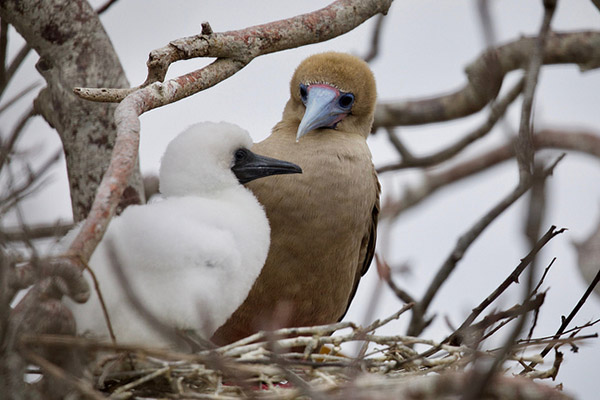- Talk with an expert insider!
- USA & Canada: 1-773-280-9571
- Ecuador: +593-987-004-404
- [email protected]

The Galapagos Red Footed Booby

Why Ecuador is Heaven for Active Travelers
January 29, 2020
Trace of the Incas in Ecuador
February 25, 2020The Galapagos red footed booby is a remarkable bird that many visitors to the Galapagos hope to see during their Galapagos Islands cruise or land based Galapagos trip. This creature lives in tropical locations in the Indian, Atlantic, and also the Pacific Ocean. It does not migrate, so it stays in the same area year-round. While the red footed booby is not endemic to the Galapagos Islands, it is nonetheless an interesting species, and it captures the attention of visitors due to its red feet, after which it is named. Here we will explain everything you need to know about the red footed booby, including its characteristics, its behavior, where to see them, and our recommendations too.
Red-Footed Booby Characteristics
One of the most noteworthy characteristics of the Galapagos red footed booby is its bright red feet after which it is named. The feet are very distinctive, making them easy to identify. The bill and pouch of this bird are pink and blue. The red footed booby comes in different colors. While many are mostly white, with some black feathers, the type in the Galapagos Islands is mostly brown. Some white ones occur there, but not so many, and when seen they could easily be confused with the Nazca booby if it wasn’t for the red feet. The fact that red footed boobies can appear differently to one another is known as “polymorphism”. It is not clear why polymorphism occurs.
Red footed boobies are the smallest of the birds within the booby species and are on average 28 inches long (70 centimeters) though their wingspan can reach 3 feet 3 inches (one meter) in length. Adult males typically weigh around 1.8 pounds, or 837 grams. Red footed boobies can live for more than 20 years.

Red-Footed Booby Behavior
Being a sea bird, it is unsurprising that the body of this creature is suited to diving for food. It has a long bill, making it easier for the red footed booby to capture its prey. This type of booby is known for its plunge diving to catch fish or squid, and they can dive up to 30 meters to do so. What is incredible about this bird is that it will travel almost 100 miles (93) to find food.
The red footed booby only comes ashore to breed, and it prefers to spend its time at sea. This means that when you see it, it will most likely be in a breeding colony. These colonies can be quite large, comprised of hundreds of individuals. Red footed boobies tend to pair for a few seasons, though not necessarily for life. During the process of finding a mate they will perform dances and rituals to attract a partner. This can be quite noisy and a bit clumsy looking. The male will often show off his bright blue throat to appeal to the female. Once the mating process is done, nests are built in big colonies. This bird mostly nests in a bush or up a tree, but on occasion it will nest on the ground. There will only be one egg which is a blue color, and both parents are responsible for making sure it stays incubated. The incubation period runs for between 44 and 46 days. The fluffy chicks are delightful to see, and they take a relatively long time to mature in comparison with other birds. It takes up to three months for the chicks to learn to fly, and longer flights may not happen for quite a lot longer. Only one egg is laid every 15 months.

Red-Footed Booby Where to See Them
The red footed booby can be observed in several spots around the Galapagos Islands. There is a colony of these boobies on Genovesa Island. San Cristobal Island also has some red footed boobies at Punta Pitt. The red footed booby can also be seen close to Floreana Island, as there is a small colony on an islet there, but your best bet is Genovesa or San Cristobal.
Cruises that offer chances to see the red footed booby with their itineraries include the Anahi Galapagos Cruise, the Infinity yacht and a few others. While there are still a number of places to see the red footed booby in the Galapagos, it is worth knowing that populations are depleting. The fishing industry is a threat that impacts on this bird’s habitat and food sources, and human habitation on the coast leaves less place for red footed booby colonies to make home.

Insider Recommendations to see the Red-Footed Booby
If you want to see red footed boobies in the Galapagos, we recommend you visit Genovesa Island. This will give you a relatively high chance of seeing this strange, red footed bird.
If you are interested in making sure you have the best chance of seeing red footed boobies on your trip to the Galapagos Islands, contact us and we can advise you on boats, itineraries or land-based Galapagos options that could be best for you.






